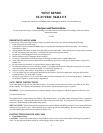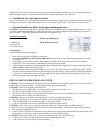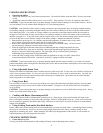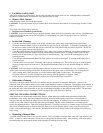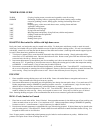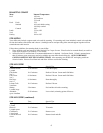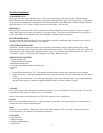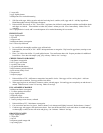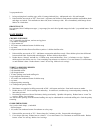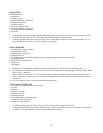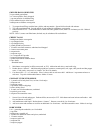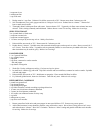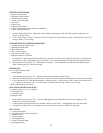3
COOKING INSTRUCTIONS
• Operating the Skillet.
1. Always use skillet on a dry, level, heat-resistant surface. Do not block airflow under the skillet. Be sure your hands
are dry.
2. Attach heat control to skillet, making sure it is set at “OFF”. Plug cord into a 120 volt, AC electrical outlet ONLY.
CAUTION: To prevent personal injury or property damage, inspect cordset for damage or wear before each use. Do not
use your product if it or its cord has been damaged or if it is not working properly.
CAUTION: Your skillet has a short cord as a safety precaution to prevent personal injury or property damage resulting
from pulling, tripping or becoming entangled with the cord. Do not allow children to be near or use this skillet without
close adult supervision. If you must use a longer cordset or an extension cord when using the skillet, the cord must be
arranged so it will not drape or hang over the edge of a countertop, tabletop or surface area where it can be pulled on by
children or tripped over. To prevent electric shock, personal injury or fire, the electrical rating of the extension cord you
use must be the same or more than the wattage of the skillet (wattage is stamped on underside of skillet).
3. Preheat skillet, uncovered, for 2 to 4 minutes until desired temperature is reached, unless recipe states
not to preheat. Signal light on heat control will be on while skillet is heating.
4. Refer to the Temperature Guide in this booklet for selecting the correct heat setting. (If food is frozen,
use heat setting as indicated, but allow longer cooking time.)
5. When the signal light on the heat control goes out indicating that the cooking temperature has been
reached, add the food. Heat may be increased or decreased, depending upon personal preference and
the type or amount of food being prepared. The signal light will go on and off during cooking to
indicate that proper temperature is being maintained.
6. At the end of the cooking period, set the heat control at WARM for serving, or at OFF if food will be
removed immediately from skillet. After dial is set at OFF, unplug cord from wall outlet.
CAUTION: To prevent personal injury or property damage, handle the heat control carefully if you remove it from the
product immediately after cooking because the metal probe will be hot-do not touch the metal probe or let it touch any thing
or surface which may burn.
• Using Adjustable Steam Vent.
Skillet cover features an adjustable steam vent built into base of the cover knob. To open vent, move flat disc in direction of
“open” arrow as printed on disc. To close vent, move disc in direction of “close” arrow as printed on disc. Typically, the
steam vent should be closed to retain moisture when simmering or roasting foods. Open steam vent to release moisture
when frying foods or to reduce liquid.
• Using Cover Rest
If cover features a cover rest, you can use it to hold the cover open when checking foods during cooking. Securely attach
notched opening of cover rest on side of skillet (without handle). To replace cover onto skillet, lift cover off and place
cover on skillet.
CAUTION: To prevent personal injury or property damage, never attach cover rest to skillet when serving foods. Always
remove cover from skillet when serving.
•
Cooking with Butter, Shortening and Oil.
Foods may be prepared with or without butter, shortening or oil. When frying, using a small amount will improve the
flavor, color and/or crispness of meat, fish, poultry and eggs. Skillet is not designed to deep fry. Never use more that one
cup of vegetable or peanut oil for shallow pan frying. Meat may be cooked in its own juices if skillet is covered and heat
control set at SIMMER.
• Using Cooking Tools on the Non-Stick Surface.
Plastic, rubber and wooden cooking tools are recommended for use on the non-stick surface. Smooth-edged metal cooking
tools may be used with care. However, do not use sharp-edged metal tools (forks, knives, mashers, beaters or food
choppers) as scratching may occur. Minor scratching will affect only the appearance of the surface; it will not harm its
non-stick property or the food prepared in the skillet.
CLEANING INSTRUCTIONS
• Clean After Every Use.
To keep your skillet looking attractive and cooking efficiently, clean it thoroughly after each use.



